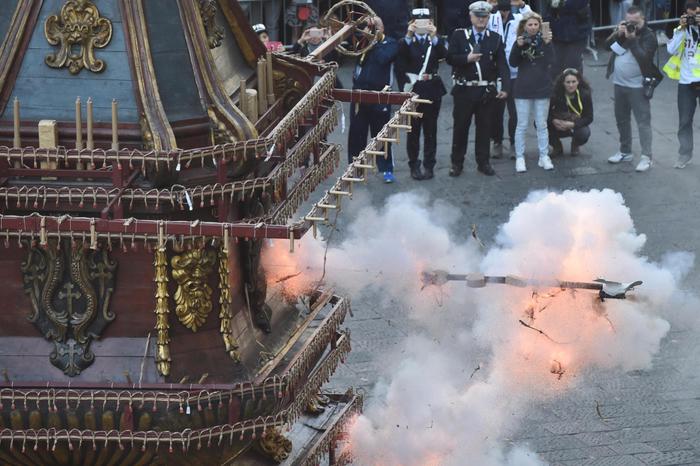The neighborhood of La Araña, to the east of the city of Malaga, rises above the sea next to a huge outcrop of limestone.
It is a solid hill used as a quarry to manufacture cement, in whose entrails fresh water from the rain and salt from the Mediterranean mix.
This border struggle dissolves this type of rock with particular zeal and has created, over thousands of years, exceptional underground caves.
In 2021, the HeidelbergCement works ran into the mouth of one of them.
It is believed that until then no human being had stepped on it and a recent scientific study highlights its international relevance due to the "very unusual" geological elements it contains, especially a set of stegamites, formations only previously described in three other cavities around the world. .
The problem is that commercial interests collide with those of science and complicate the role of the Administration.
In between, the Spanish Association of Speleology and Canyoning (Asedeb) has denounced a possible blasting that would make it disappear to the Environment Prosecutor's Office.
The paradox of this new cave, which extends for more than a kilometer underground, is that the exploitation of the quarry that allowed its discovery may also end it.
There is no date, nor permits, according to the Junta de Andalucía, to install the dynamite, but the speleologists believe that there is an agreement between the Administration and the company to take that step soon, which would end in seconds what nature has sculpted during millions of years.
This is what they have denounced before the Prosecutor's Office in a letter in which they point out the existence of several possible crimes, including damage to the natural and historical heritage and prevarication.
The regional Administration indicates that it is studying the richness of the cave and that “there are still no definitive conclusions” about it.
View this post on Instagram
A post shared by Asedeb (@asedeb_info)
The company assures that it has no intention of blasting, for the moment, and that it collaborates with the Junta de Andalucía "until a final decision is adopted".
That is, keep it or destroy it.
“The cave is like an open geology book.
Malaga cannot go down in the history of science as the city that has ended something unique in the world”, underlines José Enrique Sánchez, president of Asedeb.
Some 4,000 people have supported the preservation of the cavity on Change.org.
The cave could not be opened to tourism in the future due to the complexity of its galleries and, above all, because the human presence would bring irreversible consequences to its interior.
It can only be a place of study for science, unless it disappears, as speleologists fear.
Specialists believe that, if the cavity had been found anywhere else, the Junta de Andalucía would have preserved it, something that would also happen if there were human remains or prehistoric art, something that has almost been ruled out.
The problem is that the quarry is an administrative concession to the cement company HeidelbergCement and, for example, if the Andalusian Government prohibited the use of that land, it would have to financially compensate the company.
Without official calculations, it is estimated that it could be several tens of millions of euros.
crystals for sale
The first time the grotto was known was in the summer of 2021, when several specialists saw advertisements on the internet for the sale of rock crystals from La Araña.
There are several well-known galleries in the area, but the pieces were so unique that they suspected that a new one had been discovered.
They got it right.
That spring, while the cement machines were drilling into the limestone, they had found an opening.
The works were paralyzed and technicians from the Junta de Andalucía analyzed the finding.
Meanwhile, Juan José Durán, a researcher at the Geological and Mining Institute of Spain, who spends the summer in Malaga, offered to study the interior.
With patience, he got permission, but not funding: they gave him three months to investigate and many facilities for it.
He came in the first day they let him.
The interior of the Estegamitas cave in La Araña (Málaga). Francisco Gutiérrez Ruiz
“It was like opening a door and suddenly finding yourself in Burgos Cathedral.
At first glance, I knew there was something exceptional, but I had to study it and make an inventory”, explains Durán, who has visited hundreds of caves on five continents and had never seen anything like it.
The expert believes that, except for the vandals who stole some crystals, no human being had ever passed through there, so it is a unique opportunity that other specialists joined.
Among them is Iñaki Vadillo, professor in the area of External Geodynamics at the University of Malaga, and a group of cavers from the Excursionist Society of Malaga.
From April 10 to July 10 of this year they visited the cave on several occasions, in which they obtained "unexpected and spectacular results", according to the subsequent report.
The gallery extends for 1,303 meters and descends from six meters above the sea to at least 26. It is a territory that has been mapped in two and three dimensions without finding another way out, although the existence of mobile coverage in some corners implies closeness to the surface.
The morphologies created by the action of water and the dissolution of limestone are multiple.
"There are rooms of a certain magnitude and numerous speleothems," insists Vadillo.
They come in all shapes and sizes: discs, shields, and even so-called
pool fingers
, rarities that emerge under small gaps.
Another view of the Estegamitas cave. Francisco Gutiérrez Ruiz
The most striking are the stegamites, formations that emerge from the ground and have a rounded shape with multiple points, like a stegosaurus, the dinosaur from which they take their name.
So far they have only been found in three caves in Puerto Rico, Australia and Slovakia, but in none of them are there more than a hundred "in perfect condition" like those in Malaga, according to the report, which qualifies them as a "geological landmark". of global relevance” because some rise a meter and a half above the ground and many are still growing, alive.
Small remains of small mammals, colonies of bats and some large fossil bones have also been found, as well as incisions in the rocks that they believe could be brown bear claws or anthropogenic engravings.
Researchers continue to collect data by collecting rock, water and sediment samples and measuring temperature and carbon dioxide.
“There is still a lot of work to be done”, emphasizes Durán, who will present his conclusions next Monday at the Rector's Office of the University of Malaga.
He may be one of the first and last human beings to visit what, for now, has been baptized as the cave of the Stegamites.
Both the researchers and the speleologists assure that the conservation and the exploitation of the quarry are compatible options, but they work against the clock to obtain the most information “just in case”.
Subscribe to continue reading
read without limits
Keep reading
I'm already a subscriber







